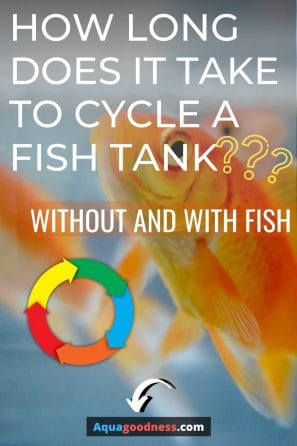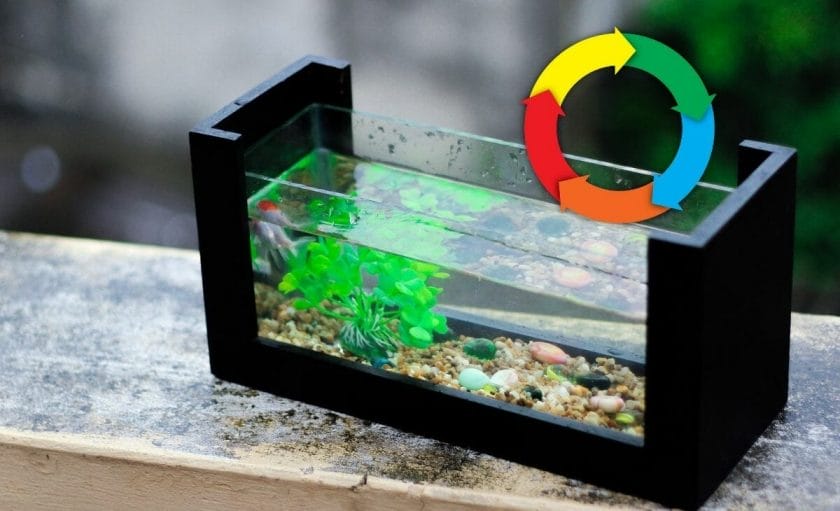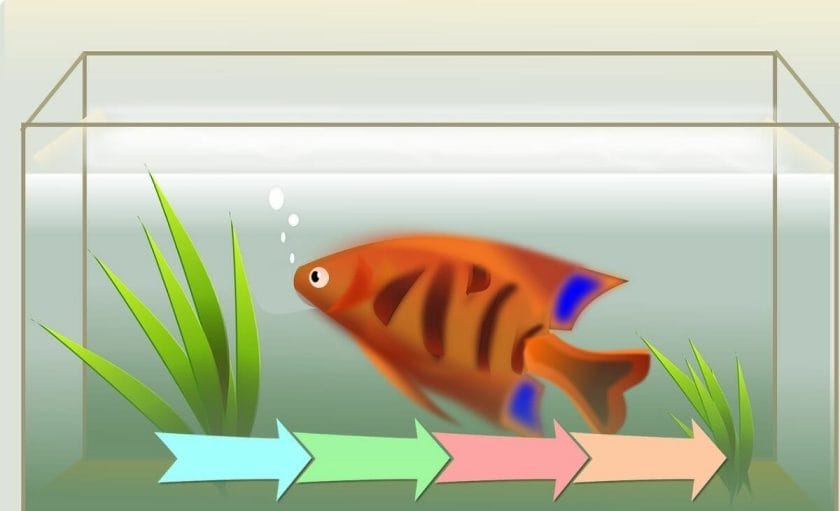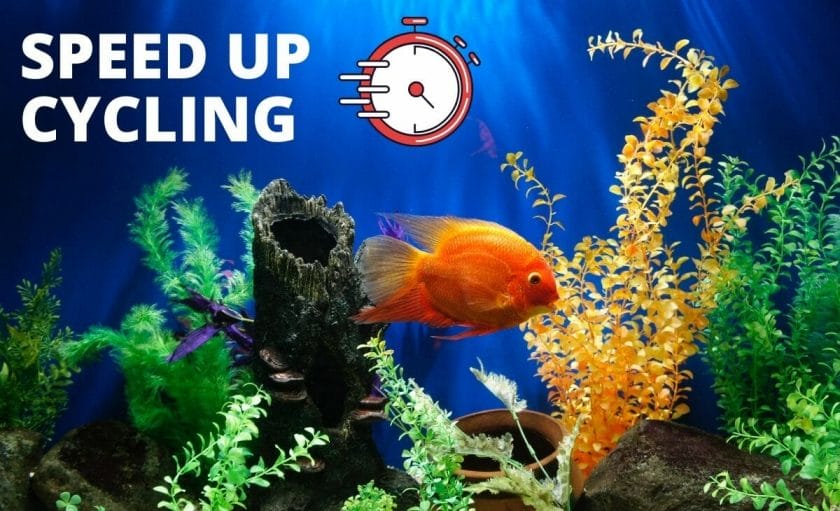You got the fish tank and you know you need to cycle it before adding fish in your tank.
So you started the nitrogen cycle and it’s been a while. But now you are wondering, how long does it take to cycle a fish tank before adding the fish?
Well, in this article, I am going to answer the same question.

It can take four to eight weeks to complete the nitrogen cycle. Once you noticed zero ammonia and nitrites level and nitrates level below 40 PPM the nitrogen cycle is completed. And now you can add fish in your aquarium.
Table of Contents
How long does it take to cycle a tank without fish?

There are two ways to cycle a fish tank without fish
- Cycling the tank using fish food
- Cycling the tank using pure ammonia
Usually, if you use fish food to cycle your fish tank then it takes more time to complete the nitrogen cycle compared to you if you use pure ammonia in your tank.
The reason for this is when you add fish food in your tank, first of all, the fish food needs to decompose to produce ammonia in your tank.
And this process can take two to three or more days depending on the heterotrophic bacteria present in your water. And oxygen level present in your tank and the temperature of the water in your tank.
On the other hand, when you add ammonia in your tank, you are basically adding the ammonia directly in your tank so you don’t have to wait for ammonia unlike in the case of fish food.
Overall, it can take anywhere between 4 to 6 weeks to cycle a fish tank without fish.
13 Easy to Care Freshwater Fish (That Look Cool!)
How long does it take to cycle a tank with fish?

It can take anywhere between 6 to 8 weeks to cycle a fish tank with fish.
In the fish-in cycling method, you‘re using fish waste as an ammonia source.
Once you set up the fish tank and added the fish, as you will feed the fish, and then the fish will produce waste in the tank.
Now this fish waste will break down and get converted into ammonia.
After a few days or weeks, the beneficial bacteria will start populating in your tank. And it will convert the ammonia into nitrites. And then nitrites into nitrates.
You’ll need to test the water of your tank every other day using a test kit like API test kit.
When you start noticing that the ammonia and nitrite levels in your tank are 0 and some nitrate levels (ideally below 50 PPM the less the better) then your nitrogen cycle is completed.
And now you can add fish in your tank.
The whole nitrogen cycle process with the fish-in cycling method can take 6 to 8 weeks to complete.
52 Best Freshwater Aquarium Plants For Beginners
How do I know when my aquarium has cycled?

No matter which method you use to cycle your fish tank whether that is the fishless cycling method or fish in cycling method once the ammonia is introduced in your tank the latter process is the same in both cases.
Once the ammonia is introduced, after a few days, the ammonia will break down into nitrite.
And at this stage, you will notice ammonia level reducing in your tank and nitrite level slowly rising in your tank.
Then after a few days or weeks, you will see the nitrites level slowly decreasing and the nitrates level slowly increasing in your tank.
You can conclude that the nitrogen cycle is completed when you notice 0 ammonia level, 0 nitrite level, and nitrate level below 25 parts per million (PPM).
At this point, your fish tank is safe for the fish and you can add fish in your tank if you have not already added it.
Do I Need to Cycle My Tank Before Adding Live Plants?
How can I speed up cycling my fish tank?

There are several ways to speed up this fish tank cycling process.
Get the basics right
Most of the time beginners ignore the basics of cycling a fish tank which slows down the cycling process or worst can stall the cycling process.
So let’s start with the basics.
1. Dechlorinate the water
Drinking water contains chlorine for a good reason. It kills harmful stuff from the water and makes it safe for drinking.
However, chlorine is harmful not only to fish but also to beneficial bacteria.
That’s why it is very important to dechlorinate the water before adding it in your tank. Or else, the beneficial bacteria will not grow in your tank and the nitrogen cycle will never start.
You can easily dechlorinate water using a dechlorinating agent like Seachem prime
You can check its reviews and buy it from Amazon here.
2. Keep an eye on the pH
This is the most overlooked basic thing when it comes to cycling a fish tank.
You need to keep the pH of the water of your aquarium above 7 so that the beneficial bacteria can keep growing in your tank.
Usually, you don’t need to worry about the pH because your drinking water most likely has pH above 7.
However, it is always a good idea to test the water for the pH and make sure that it is above 7. You can easily test the water using a test kit like API test kit.
You will need this test kit to measure the nitrate, ammonia, and nitrates level later as well.
Tip: Don’t go for the test strips instead go for the API test kit (the liquid one) because it is pretty accurate.
If you noticed the pH of the water in your aquarium is lower than 7 then simply doing a water change of about 20% can increase the pH above 7.
3. Increase the temperature
This is a very unique tip!
Beneficial bacteria grow better in warmer temperatures. And the whole point of the nitrogen cycle is to get as much beneficial bacteria as possible in your tank in as little time as possible.
So it just makes sense to increase the temperature of the water in your tank up to the degree to which it is optimum for the reproduction of beneficial bacteria.
The ideal temperature for beneficial bacteria is between 83 to 87 degrees Fahrenheit.
Now one word of caution for increasing the temperature is you should only increase the temperature in your tank if you are doing fishless cycling.
Because the temperature up to 87 degrees Fahrenheit can be stressful for some types of fish.
4. Increase the oxygen levels in your tank
If you are going to increase the temperature in your tank then you will also need to increase the oxygen levels in your tank. Because warmer water has a very low capacity of holding oxygen.
And just like us, the beneficial bacteria also need oxygen to survive and grow in your fish tank.
Now even if you are not going to increase the temperature in your tank, increasing the oxygen levels in your tank will help the beneficial bacteria to survive and grow in your tank.
You can easily increase the oxygen levels in your tank using an air pump.
We command the Tetra whisper air pump. It is a pretty popular and reliable air pump.
You can check its latest price and reviews at Amazon here.
5. Never shut down the filter
This is the mistake many beginners make especially with fishless cycling.
They think that as there’s no fish in the tank it is a good idea to turn off the filter for a while or during the night or during the day or whenever.
Except, it is not!
The thing is, the sponge or the filter floss present in your aquarium filter is the best place for beneficial bacteria to grow and form their colonies.
Because the sponge is porous so it provides a lot of surface area for beneficial bacteria to form their colonies.
And in the filter, if you don’t turn it off ever then there is a continuous flow of water and dissolved oxygen. And beneficial bacteria does need continuous water to stay alive!
That’s why you should never turn off the filter of your aquarium during the nitrogen cycle even if you are using the fishless cycling method to cycle your tank.
Now the basics are out of the way, let’s move to the other things you can do to drastically speed up the nitrogen cycle process in your tank.
11 Things you can do TODAY to Keep your Goldfish Happy for Forever in your Aquarium
Get a filter media from the filter of an established tank
This is a very common and probably most effective way of speeding up the nitrogen cycle process in your new tank.
As I mentioned earlier, an aquarium filter is the best place for beneficial bacteria to grow.
So if you can manage to get a filter media from an established tank i.e. the tank whose nitrogen cycle is completed and it contains a lot of beneficial bacteria then it will jump start the nitrogen cycle process in your tank.
Because by doing so you’re basically introducing the live beneficial bacteria in your new tank. So you don’t have to wait for beneficial bacteria to naturally start populating in your tank which can take weeks!
Caution: When getting the filter media from an established tank only take it from a trusted source. Because when you are adding the filter media from an established tank in your filter, you are not only introducing beneficial bacteria but you may also be introducing any harmful disease-causing bacteria in your tank from the tank in your tank.
15 Mistakes Beginners Make with their Goldfish Tank (How to avoid them)
Add a bottle of beneficial bacteria in your tank
As we are on the point of adding the beneficial bacteria in your tank, there are several brands that sell bottles of beneficial bacteria.
You just have to pour down the bottle into your tank to jump start the nitrogen cycle process.
There are a few reputed brands that sell bottles of beneficial bacteria. I have listed them below.
- Dr.Tim’s Aquatics Freshwater One & Only Nitrifying Bacteria- See its reviews at Amazon here
- Fritz Aquatics FritzZyme 7 Nitrifying Bacteria for Fresh Water Aquariums- See its reviews at Amazon here
Why is my fish tank taking so long to cycle?

There could be a few reasons your fish tank is taking so line long to cycle.
High ammonia or nitrite levels.
Ammonia level above 4 PPM is toxic for the beneficial bacteria.
So you should check the ammonia levels in your tank.
You can check the ammonia levels using API test kit.
If the ammonia level is above 4 PPM then you should do a partial water change to reduce the ammonia.
A high nitrite level can also stall the nitrogen cycle.
The nitrite level in your aquarium should not be above 4 PPM.
You can check the nitrite levels using API test kit.
After testing the water if you noticed that the nitrite level in your tank is above 4 PPM then you should do a partial water change to reduce the nitrite level in your tank.
Do Aquarium Plants Absorb Ammonia?
Low pH of the water
The nitrogen cycle process of your aquarium can slow down or even stop if the pH of the water of your aquarium is below 7!
You can easily check the pH of the water in your aquarium using a test kit like API test kit.
If you noticed that the pH of the water in your tank is lower than 7 then there are a few ways to increase to easily increase the pH of the water of your aquarium
Partial water change
The pH of the water in your aquarium decreases as pollutants build up in your aquarium.
During the cycling process, you may be using different ammonia sources like fish food or pure ammonia or in the fish-in cycling the fish waste.
These sources release ammonia as well as other pollutants in your aquarium which lowers the pH of the water in your tank.
So when you do a water change you’re basically lowering the concentration of the pollutants which helps to increase the pH of the water in your tank.
Aerate the tank
The pH of the water decreases if the water in your aquarium contains a very concentrated amount of carbon dioxide.
This is because carbon dioxide is acidic and it produces carbonic acid in your aquarium water.
And when there is a high amount of carbonic acid in your tank the pH of the water decreases.
Increasing dissolved oxygen in the tank can help to reduce the concentration of carbon dioxide and so carbonic acid which will help increase the pH level in your tank.
There are several ways to increase oxygen levels in your tank.
But using an air pump is the easiest and most reliable way to increase oxygen levels.
You can introduce an air pump in your tank. The air pump will produce bubbles in your tank which will disturb the surface of the water of your tank.
As gas exchange happens on the surface of the water of your tank, the Oxygen will get dissolved in your aquarium water. And carbon dioxide will get released into the air which will help to increase the pH of the water in your tank.
6 Tips to Take Care of Live Plants in Aquarium (For Beginners)
How can I cycle my fish tank in 24 hours?

There are a couple of ways of cycling a fish tank instantly!
1. Using filter media of a filter from an established tank
This method is quite popular, common, and simple to cycle your tank instantly. You don’t even need to wait 24 hours!
If you already have an established tank then you can simply pull out the filter media from the established tank and add it into the filter your newly setup tank.
For example, if you have a sponge filter in your established tank then you can remove the sponge from the filter of the established tank and replace it with a new one.
And then replace the sponge from the established tank with a new sponge filter.
If you have a hang on the back filter in your established tank then you can pull out the filter floss from the filter of the established tank. And put it inside a new filter which you are going to use in your new tank and then fix the filter in your new tank.
Or if you have a hang on the back filter in your established tank and you want to use a sponge filter in your new tank. Then you can pull out the filter floss from the filter of the established tank and put it between the sponge filter and the glass of the new tank. This will seed the beneficial bacteria into the sponge filter.
If you have two filters in your established tank then you can simply pull out one of the filters and add it to your new tank.
The basic ideology behind this method is you are pulling out the filter or the filter media from an established tank that has already a lot of beneficial bacteria and putting it in your new tank.
So when you add fish in the new tank and when it will produce ammonia in the tank, you will already have beneficial bacteria to convert the ammonia into nitrite and then into nitrate.
Do I Need Soil for Aquarium Plants? (Best Substrate for Plants?)
2. Adding a bottle of live nitrifying bacteria into your tank
There are several brands that sell live nitrifying bacteria in small bottles.
The ideology behind this method is pretty similar to the method mentioned above.
You are basically adding the beneficial bacteria from the bottle into your tank so your tank will already have beneficial bacteria to convert the waste produced by fish into nitrates which is less harmful to the fish.
Now there are several brands that sell live beneficial bacteria in bottles.
But the problem with these bottles is that, by the time you get the bottles of live beneficial bacteria, the beneficial bacteria are not alive!
This doesn’t happen all the time but it can happen.
Some people will get the bottles that have live beneficial bacteria and some will get that have dead beneficial bacteria.
So the lucky ones will have live beneficial bacteria to jump-start their nitrogen cycle.
Below are some of my recommended live beneficial bacteria products.
People had a good experience with these products
- Dr.Tim’s Aquatics Freshwater One & Only Nitrifying Bacteria- See its reviews at Amazon here
- Fritz Aquatics FritzZyme 7 Nitrifying Bacteria for Fresh Water Aquariums- See its reviews at Amazon here
Tip: When you use any of the methods mentioned above to cycle your tank, in the beginning, don’t add a lot of fish in the tank. You should add a couple of fish for a couple of weeks and then slowly you can add more if you will.
20 Tips to Maintain a Healthy Aquarium
Conclusion
Overall, if you are doing fishless cycling or fish-in cycling, usually it can take anywhere between four to eight weeks for the nitrogen cycle to complete.
You can instantly cycle a fish tank using by adding a filter or filter media from an established tank or by adding a bottle of beneficial bacteria in your tank.
Waiting for the nitrogen cycle to complete can be frustrating. But it is essential to create a healthy ecosystem for your fish.
I hope you found this article helpful.
If you do, please share it.
Happy fishkeeping!